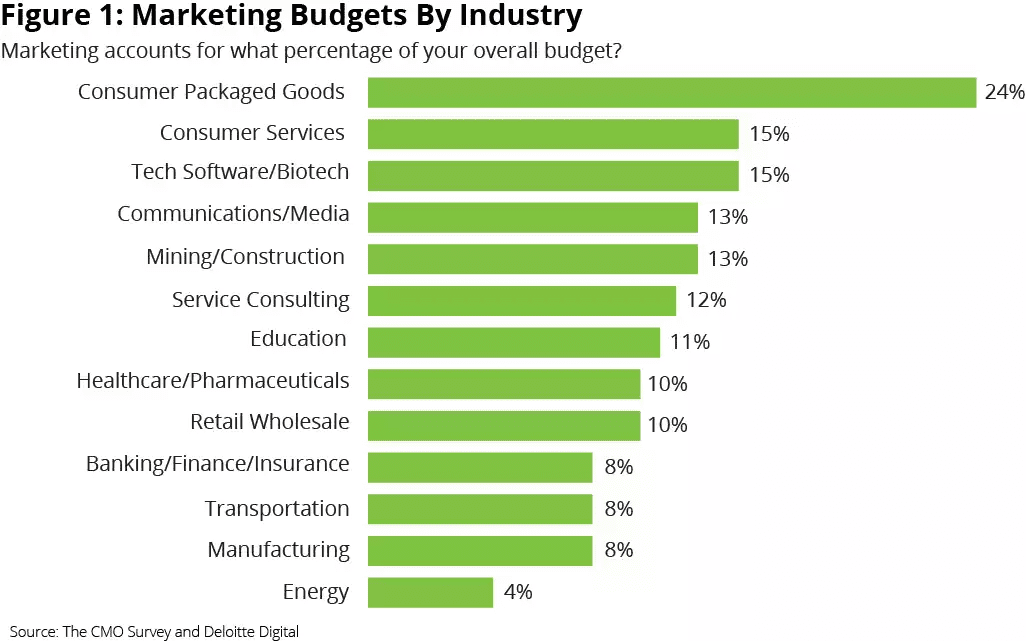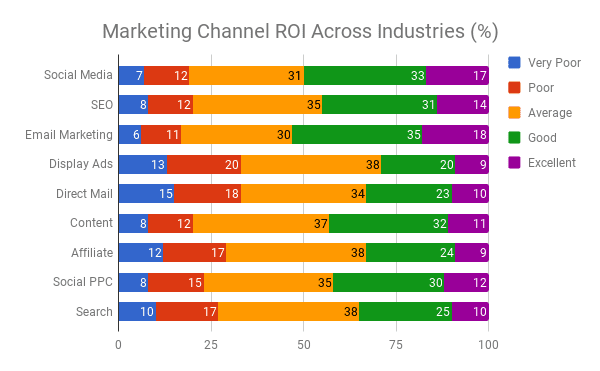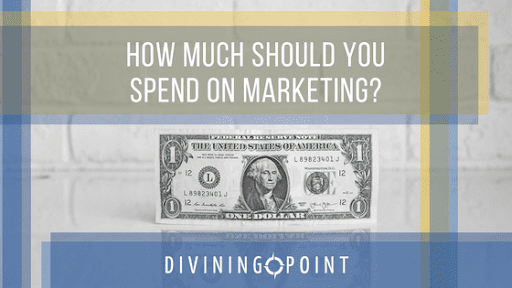We often get asked “How much should I spend on marketing?” It’d be nice if the answer was easy, but it’s not. There is no predetermined percentage of revenue that applies to all businesses. The ideal number takes into account what you’re offering, where you’re offering it, and who you’re competing against. We’ve probably all heard, “you’ve got to spend money to make money,” and this certainly applies to digital marketing. The trick is knowing how to make your expenditures generate returns.
Industry Spending
Traditionally, the amount to spend on marketing usually depended on the offering and industry. For a company selling a product, it’s recommended that no less than 15% of revenue be spent on marketing just to maintain market share. However, a consumer goods company could spend up to 25% or higher, depending on goals. For professional services, typically no less than 10% of revenue should be spent to maintain market share, and up to 20% or more to increase growth.
For more conservative numbers, the U.S. Small Business Administration (SBA) recommends businesses invest 7% to 8% of gross revenue for marketing and advertising if they are generating more $5 million a year in sales with a net profit margin between 10% – 12%.
The SBA says that B2B firms typically invest 6-7% of revenue in marketing, but businesses with less than $25 million per year in revenue ordinarily spend more than 10% on marketing on average.
In a 2017 survey, Deloitte and Duke University, asked CMOs what percentage of their budget is spent on marketing. The results are below:

As you can see above, professional services companies – tech software, mining, construction, etc. – are spending the industry average, or more, on marketing. But, SaaS Companies don’t always stick to the the rules. Here are some examples of companies who spent way more on their 2016/2017 marketing budget and experienced great results [Vital Designs].
- MindBody – 40% of revenue invested in marketing, 37% revenue growth year-over-year
- Salesforce – 49% of revenue invested in sales and marketing, 24% revenue growth year-over-year
- Tableau – 58% of revenue invested in sales and marketing, 27% revenue growth year-over-year
We’re not suggesting that you drop nearly half of your annual revenue on marketing. But increasing your investment in your marketing strategy will be the thing that sets you apart from your competitors. It is your secret weapon to get ahead.
For professional services, you have to dig a little deeper. The cost of easily consumable content for your website can really vary depending on the complexity of the subject matter and the length of the topic. A short blog post could be as low as a few hundred dollars, whereas an e-book or white paper could run you a few thousand dollars. Social media marketing that is guaranteed to drive traffic to your website typically starts at no less than $2,500 per month – with some robust, national campaigns coming in between $10,000-$20,000 per month. A strong SEO strategy with both onsite and offsite ordinarily runs between $1,500-$5,000 per month, with some companies spending double those amounts monthly.
What are average rates for digital marketing? A survey conducted by Moz, a leading SEO website, of over 600 agencies resulted in the following summary:
- Digital Marketing hourly rates range from $76–$200/hr
- Project-specific pricing ranges from $1,000–$7,500
- Most monthly retainers cost between $2,500-$5,000/month
And, using a mean value between what’s recommended by the SBA (10%) and what we recommend (15%), your overall marketing budget should probably be about 12.5% annual revenue. Breaking that down even further, multiple sources, including Forrester Research, have indicated that digital marketing currently averages about 30% of total marketing spend. So, in a very general sense, your digital marketing budget should be about 3.75% of your annual revenue (30% of 12.5% = 3.75%) .
Here’s an example:
A B2B firm providing technology services to other businesses with $8M in annual sales might budget $300,000 (3.75% x $8,000,000) ($25,000/month), which would likely include website, conversion rate optimization, SEO, social media management and a mix of paid advertising campaigns with Google AdWords, Facebook and LinkedIn – including ad spend.
How to Spend It
After settling on a number for your marketing budget, the next big challenge is deciding how to spend it. Another CMO survey from Forrester Research and eMarketer show the estimated allocation of marketing funds offline vs. online and across the digital channels.
Here are some conclusions from that report [source: WebStrategies]:
- In 2018, the average firm was expected to allocate 41% of their marketing budget to online, and this rate is expected to grow to 45% by 2020
- Search engine marketing will capture the largest share of online spend with online display (banner ads, online video, etc.) taking the second largest share
- Social media advertising investments will continue to grow, with a 17% compound annual growth rate from 2016 to 2021, and is expected to represent 25% of total online spending in 2018.
- Mobile marketing has grown to a point that it’s no longer tracked in the forecast and it’s presumed to be considered across all channels
- Digital marketing is pacing at an 11% compound annual growth rate between 2016 and 2021 with the biggest growth occurring in online video.
- Investment in paid search, display advertising, social media advertising, online video advertising and email marketing is predicted to account for 46% of all advertising by 2021.
Why are companies investing in social media and other online channels? A recent survey of 2,500 digital marketers showed that the most effective marketing tactics (email marketing, organic search, social media marketing and content marketing) generated better ROI than traditional (brochures, trade shows, etc) [source: GetResponse].

A Home For Your Brand
However, before any social media or content marketing is launched, a company must have a fully developed brand that is clearly defined on a website with a user-friendly experience. The products and services you sell and the promises you make must be explained in a compelling way that engages the visitor from the moment they arrive at your homepage. Your website is the entrypoint to the sales funnel. You must lure people in instead of turning them away.
Research supports this, but intuitively we all follow the same behavior. When was the last time you hired a company without looking at their website first? Probably in the ‘90s, right? We all do our Google research. We even visit social media to continue our research. Over 80% of people look up a company online before visiting the business or deciding to buy.
Before visitors become your customers, they have to know that you exist and what you do. Does your homepage make it clear what you’re offering? Is there an obvious action they should take – “Call Us Today!” – or an email sign-up? Of your potential customers, most are looking at your website on their mobile device. Is your site optimized for a smartphone? What’s their first impression of your company?
The value of the investment in your site cannot be underestimated. You may be able to get by with a basic website with little to no brand messaging and conversion methods, but you’ll cap the potential for revenue growth with
Invest In Success
If you don’t set aside a large chunk of your budget for an excellent online presence, you can count on your customers going to a company that does. Under-investment in your digital marketing strategy results in “leaving money on the table,” because your customers are going to work with your competitors with a great website and engaging online presence.
Have questions about budget or what strategy your company should use? For professional services and technical companies, it can be frustrating knowing just how much to spend on marketing and where to spend it. At Divining Point we specialize in working with companies who promise quality service as a part of their business model. Give us a call and we’ll get you on track.
Ready to take your business to the next level? Contact us. We’re here to help.

